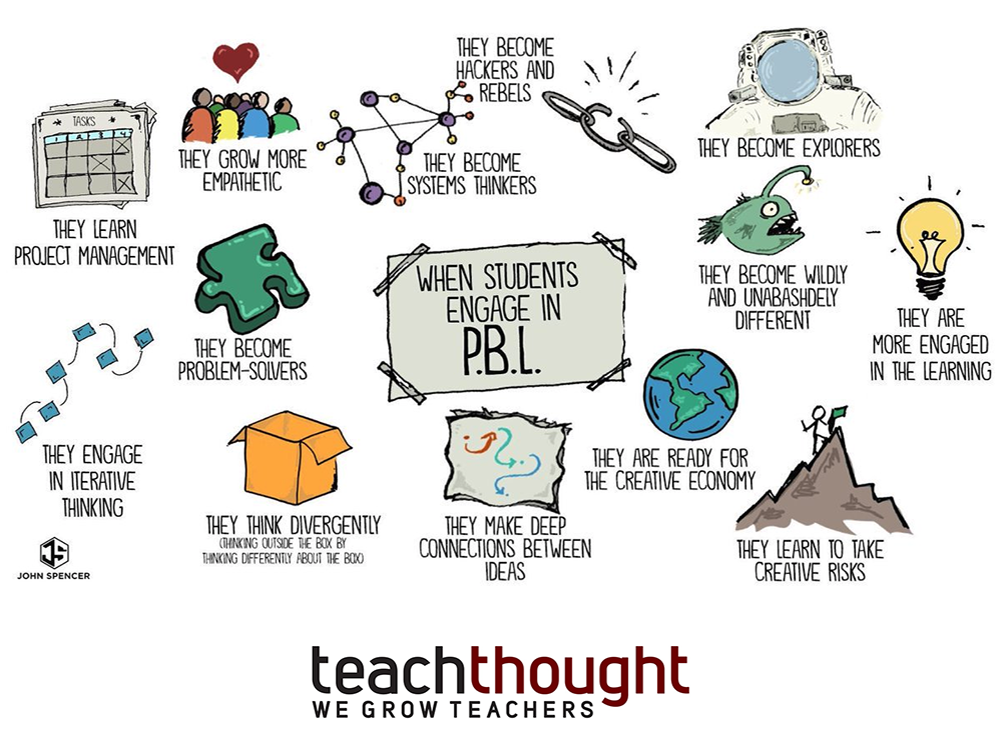
13 Brilliant Outcomes Of Project-Based Learning
by Terry Heick
Project-based learning isn’t a ‘trend’ any more than mobile devices are a trend.
Mobile devices–smartphones, for example–simply provide a (physical) framework to host hardware (e.g., iris scanners, cameras, etc.) and software technology (e.g., an operating system, apps, etc.) These devices in and of themselves aren’t as much of a ‘trend’ as are the things that they enable. Project-based learning is kind of like that.
As the name implies, project-based learning is simply learning through projects. What is being learned and how that learning is being measured isn’t strictly dictated by the project and any products or artifacts within that project. Rather, the reverse should be true: the desired learning objectives should help dictate the products and artifacts within the project.
For example, instead of wanting students to plan a garden as the core of the project, then deciding which learning objectives and academic standards fit that idea, planning backward–looking first at the learning objectives and academic standards, then brainstorming project ideas and components of that project (audience, purpose, duration, etc.) This can be useful in making sure that in the course of completing the project, they are actually learning what you want them to learn. That is, you can help align the work of the project with the desired learning outcomes and objectives.
(To further complicate matters, there are also different types of project-based learning.)
For whatever reason, PBL is widely misunderstood—which is why I was happy to see the following graphic from John Spencer, who allowed us to share it with you along with our other PBL resources. The graphic clarifies 13 potential outcomes of well-designed project-based learning. Obviously, not all are true every time for every student in every project in the same way that not every app on a smartphone works well, nor does every bit of hardware function the way it’s intended to.
It’s all a matter of design and quality.
For now, on to Spencer’s outstanding graphic. For each potential outcome of PBL, I added a tip or strategy to help increase the chance that this potential is realized. Add any tips of your own in the comments below, and let us know what future PBL content you’d like to see that would help you as a teacher.
13 Brilliant Outcomes Of Project-Based Learning
1, They learn project management.
Strategy: Use a project management board–even one used primarily by adult professionals–to help students manage individual or team projects. Trello is a great example, as is Redbooth.
2. They grow more empathetic.
Strategy: Begin project-planning with a specific audience with a specific and pressing concern.
3. They become hackers and rebels.
Strategy: Let students design their own projects. Or require that projects iterate or counter existing cultural trends and patterns or address compelling social concerns (e.g., technology addiction).
4. They become systems thinkers.
Strategy: Use concept mapping before, during, and after completing the project.
5. They become explorers.
Strategy: Design projects that require students to combine both a physical and digital presence and physical and digital ‘behaviors’ and contexts. For example, a social media component combined with a local, community-based outcome.
6. They become problem-solvers.
Strategy: Use problem-based PBL–that is, projects based around a problem that requires critical thinking to solve.
7. They become wildly and unabashedly different.
Strategy: Give ‘points’ or other encouragement mechanics to reward students who deviate in some way that improves the quality of the work. For example, add a ‘free letter grade’ increase for students who take risks or develop ‘non-traditional’ solutions to otherwise ‘traditional’ social problems and concerns.
8. They are more engaged in the learning process.
Strategy: Create checkpoints in the project’s life cycle–or better yet, have students suggest their own checkpoints, then be responsible for checking in, what kind of feedback that would be useful and from whom, etc.
9. They are ready for the creative economy.
Strategy: Give students the opportunities to use their specific gifts, skills, and backgrounds in completing the project.
10. They engage in iterative thinking.
Strategy: Use model-based learning that allows students to identify and transfer existing ideas into new contexts and applications. For example, allow students to take an idea (Amazon’s platform business model) and apply it to family businesses, recycling programs, or creative efforts like music and art.
11. They think divergently. (Thinking outside the box by thinking differently about the box.)
Strategy: See #3 and #7. Make ‘deviation’ a core tenet, then model and reward it.
12. They make deep connections between ideas.
Strategy: Use cross-curricula planning–projects that include multiple content areas. This complicates the planning, but it also makes it more immersive academically. And like #4, concept mapping is a useful way to help students see the relationships between ideas.
13. They learn to take creative risks.
Strategy: Help students brainstorm the opportunities for creative risk-taking at the beginning of a project. Sometimes they’re not even aware of the kinds of risks that can be taken in PBL–from the scale of a project and its audience and purpose, to kinds of collaboration partners brought into the project and their talents and skills.
Also, give them a chance to change course if things aren’t working out as they thought they might.
13 Brilliant Outcomes Of Project-Based Learning
